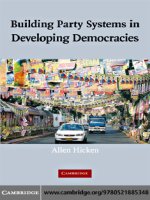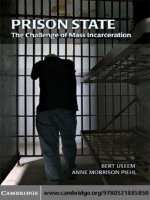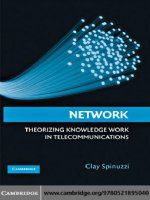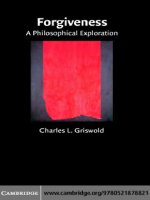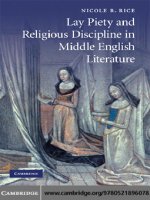cambridge university press james joyce in context mar 2009 kho tài liệu bách khoa
Bạn đang xem bản rút gọn của tài liệu. Xem và tải ngay bản đầy đủ của tài liệu tại đây (2.95 MB, 436 trang )
This page intentionally left blank
JAMES JOYCE IN CONTEXT
This collection of original, cohesive and concise essays charts the vital
contextual backgrounds to Joyce’s life and writing. The volume begins
with a chronology of Joyce’s publishing history, an analysis of his
various biographies and a study of his many published and unpublished letters. It goes on to examine how his works were received in the
main twentieth-century critical and theoretical schools. Most importantly, it places Joyce within multiple Irish, British and European
contexts, providing a lively sense of the varied and changing world
in which he lived, which formed him and from which he wrote. The
essays collectively show how Joyce was rooted in his times, how he is
both a product and a critic of his multiple contexts and how important
he remains to the world of literature, criticism and culture today.
John McCourt is Lecturer at the Università Roma. He is the author of
many studies of Joyce, most notably The Years of Bloom: James Joyce in
Trieste, 1904–1920 (2000).
JAMES JOYCE IN CONTEXT
edited by
JOHN M C COURT
CAMBRIDGE UNIVERSITY PRESS
Cambridge, New York, Melbourne, Madrid, Cape Town, Singapore, São Paulo
Cambridge University Press
The Edinburgh Building, Cambridge CB2 8RU, UK
Published in the United States of America by Cambridge University Press, New York
www.cambridge.org
Information on this title: www.cambridge.org/9780521886628
© Cambridge University Press 2009
This publication is in copyright. Subject to statutory exception and to the
provision of relevant collective licensing agreements, no reproduction of any part
may take place without the written permission of Cambridge University Press.
First published in print format 2009
ISBN-13
978-0-511-48099-7
eBook (NetLibrary)
ISBN-13
978-0-521-88662-8
hardback
Cambridge University Press has no responsibility for the persistence or accuracy
of urls for external or third-party internet websites referred to in this publication,
and does not guarantee that any content on such websites is, or will remain,
accurate or appropriate.
Contents
Notes on contributors
Preface
List of abbreviations
part i
page ix
xv
xix
1
life and works
1 Composition and publishing history of the major
works: an overview
Stacey Herbert
3
2 Biography
Finn Fordham
17
3 Letters
William S. Brockman
27
part ii
39
theory and critical reception
4 Genre, place and value: Joyce’s reception, 1904–1941
John Nash
41
5 Post-war Joyce
Joseph Brooker
52
6
Structuralism, deconstruction, post-structuralism
Sam Slote
65
7 Gender and sexuality
Marian Eide
76
8 Psychoanalysis
Luke Thurston
88
v
Contents
vi
9
Post-colonialism
Gregory Castle
10 Genetic Joyce criticism
Dirk Van Hulle
99
112
11
Translation
Jolanta Wawrzycka
125
12
Joyce and world literature
Eric Bulson
137
13
Twenty-first-century critical contexts
Sean Latham
148
part iii
historical and cultural contexts
161
14
Being in Joyce’s world
Cheryl Temple Herr
163
15
Dublin
L. M. Cullen
173
16
Nineteenth-century lyric nationalism
Matthew Campbell
184
17
The Irish Revival
Clare Hutton
195
18 The English literary tradition
Patrick Parrinder
19
Paris
Jean-Michel Rabaté
20 Trieste
John McCourt
21
Greek and Roman themes
Brian Arkins
205
216
228
239
22 Medicine
Vike Martina Plock
250
23 Modernisms
Michael Levenson
262
Contents
vii
24 Music
Timothy Martin
275
25 Irish and European politics: nationalism, socialism, empire
Brian G. Caraher
285
26 Newspapers and popular culture
R. Brandon Kershner
299
27 Language and languages
Tim Conley
309
28 Philosophy
Fran O’Rourke
320
29 Religion
Geert Lernout
332
30 Science
Mark S. Morrisson
343
31
Cinema
Maria DiBattista
355
32 Sex
Christine Froula
366
Further reading
Index
378
399
Notes on contributors
brian arkins is Professor of Classics at the National University of
Ireland, Galway. He was educated at Clongowes Wood College, and at
University College, Dublin, where he obtained an MA in Classics and a
Ph.D. in Latin. He is the author of eight books of criticism that include
Sexuality in Catullus (1982), Builder of My Soul: Greek and Roman Themes
in Yeats (1990) and Greek and Roman Themes in Joyce (1999), together
with more than 120 journal articles. Dr Arkins is a Director of the Irish
Institute of Hellenic Studies at Athens, and, in 2005, was Honorary
President of the Classical Association of Ireland.
william s. brockman is Paterno Family Librarian for Literature at
Pennsylvania State University. As Bibliographer for the James Joyce
Quarterly since 1990, he compiles the ‘Current James Joyce Checklist’.
His articles have appeared in papers of the Bibliographical Society of
America, Joyce Studies Annual and Journal of Modern Literature. He is
currently preparing a comprehensive database of writings about Joyce.
joseph brooker is Senior Lecturer in Modern and Contemporary
Literature at Birkbeck College, University of London. He is the author of
Joyce’s Critics: Transitions in Reading and Culture (2004) and Flann O’Brien
(2005). He has co-edited special editions of New Formations (on Remembering
the 1990s) and of the Journal of Law and Society (on Law and Literature).
eric bulson is Lecturer in the Department of Comparative Literature at
Yale University. His articles on Joyce have appeared in the Times Literary
Supplement, Journal of Modern Literature, James Joyce Quarterly, Joyce
Studies Annual, The Reception of James Joyce in Europe (ed. Geert van
Lernout and Wim Van Mierlo) (2004), and Palgrave Advances in James
Joyce Studies (ed. Jean-Michel Rabaté) (2004). He is the author of the
Cambridge Introduction to James Joyce (2006) and Novels, Maps, Modernity:
The Spatial Imagination, 1850–2000 (2007).
ix
x
Notes on contributors
matthew campbell is Reader in English Literature at the University of
Sheffield. He is the author of Rhythm and Will in Victorian Poetry (1999)
and the editor of The Cambridge Companion to Contemporary Irish Poetry
(2003), and Irish Poetry in the Union (forthcoming).
brian g. caraher is Chair of English Literature and Research Director
in Modern Literary Studies in the School of English at Queen’s
University Belfast. He has written on Joyce in English Literary History,
James Joyce Quarterly, Irish Review, Textual Practice, Works and Days
and elsewhere, and has published widely on topics in aesthetics,
poetics, theories of literary reading, literary pragmatics, genre theory
and cultural politics. His books include Intimate Conflict (1992), Ireland
and Transatlantic Poetics, Trespassing Tragedy (2007); and The Joyce of
Reading: Cultural Politics and Literary Pragmatics is in preparation.
gregory castle is Professor of Modern British and Irish Literature at
Arizona State University. In addition to essays on Irish literature and
history, he has published Modernism and the Celtic Revival (2001),
Reading the Modernist Bildungsroman (2006) and the Blackwell Guide to
Literary Theory (2007). He also edited Postcolonial Discourses (2000). His
current work focuses on Irish revivalism and political education.
tim conley is Associate Professor of English and Comparative Literature
at Brock University. He is the author of Joyce’s Mistakes: Problems of
Intention, Irony, and Interpretation (2003) and a collection of short
fiction, Whatever Happens (2006), and is co-author (with Stephen
Cain) of The Encyclopedia of Fictional and Fantastic Languages (2006).
l. m. cullen is Professor Emeritus of Modern Irish History, Trinity
College, Dublin. His interests have lain in Irish and French history,
business history and more recently in Japanese history. He has written on
Dublin economic development and on both the physical growth of the
city and the history of some of its major institutions.
maria dibattista is Professor of English and Comparative Literature at
Princeton University, where she is also the chair of the film studies
committee. She has written extensively on modern literature, popular
and pulp fiction and film. Her most recent book is Fast Talking Dames
(2001), a study of American film comedy in the 1930s and 1940s.
marian eide is Associate Professor of English at Texas A&M University.
She is author of Ethical Joyce (2002) and is currently writing on literatures
of political violence in the twentieth century.
Notes on contributors
xi
finn fordham is Lecturer in English at Royal Holloway College,
University of London. He is a scholar of Joyce, modernism and
compositional processes and most recently published Lots of Fun at
Finnegans Wake: Unravelling Universals (2007).
christine froula is Professor of English, Comparative Literary Studies,
and Gender Studies at Northwestern University. She has published
Virginia Woolf and the Bloomsbury Avant-Garde (2005), Modernism’s
Body: Sex, Culture, and Joyce (1996), To Write Paradise: Style and Error in
Pound’s Cantos (1984), A Guide to Ezra Pound’s Selected Poems (1983) and
many articles on interdisciplinary modernism, contemporary theory and
textual scholarship.
stacey herbert (Ph.D. Comparative Literature, SUNY Buffalo) has
curated exhibitions and digital installations on the works of Joyce, Yeats
and Beckett for the National Library of Ireland, University of Tulsa and
University of Buffalo. She focuses her work on material and archival
studies of modernism and is engaged in the ongoing production of a
digital descriptive and analytical bibliography of Joyce’s works.
cheryl temple herr teaches at the University of Iowa and is jointly
appointed Professor in the departments of English and Cinema/
Comparative Literature. Among her many publications on James Joyce
and Irish culture are Joyce’s Anatomy of Culture (1986) and Critical
Regionalism and Cultural Studies: From Ireland to the American Midwest
(1996).
clare hutton is Lecturer in English at Loughborough University. She
has edited volume v of The Oxford History of the Irish Book (forthcoming),
and written several articles on Joyce and the textual culture of the Literary
Revival. She is currently completing a book on that topic.
r. brandon kershner is Alumni Professor of English at the University
of Florida. He is the author of Dylan Thomas: The Poet and His Critics
(1977), Joyce, Bakhtin, and Popular Literature (1989) and The TwentiethCentury Novel: An Introduction (1997). He is also the editor of Joyce and
Popular Culture (1996), Cultural Studies of Joyce (2003) and the Bedford
Books edition of Joyce’s A Portrait of the Artist as a Young Man (2006).
sean latham teaches at the University of Tulsa where he serves as editor
of the James Joyce Quarterly and Director of the Modernist Journals
Project (www.modjourn.org). He is the author of ‘Am I A Snob?’
Modernism and the Novel (2003) and has just completed a new book
xii
Notes on contributors
entitled The Art of Scandal: Modernism’s Open Secrets and Hidden
Pleasures.
geert lernout teaches comparative literature at the University of
Antwerp where he is director of the Joyce Center. He has published
books on Joyce, Friedrich Hölderlin, Bach’s ‘Goldberg Variations’, the
history of the book, the Bible. With Vincent Deane and Daniel Ferrer, he
is editor of the Finnegans Wake Notebooks at Buffalo. He is a member of
the Academia Europaea.
michael levenson is William B. Christian Professor of English at the
University of Virginia. He is the author of A Genealogy of Modernism,
Modernism and the Fate of Individuality (1986), The Spectacle of Intimacy
(co-author Karen Chase) (2000) and the forthcoming Modernism. He is
also the editor of the Cambridge Companion to Modernism (1999).
john m c court teaches at the Università Roma, Tre. He is director of
the annual Trieste Joyce School and author of The Years of Bloom:
James Joyce in Trieste, 1904–1920 (2000) and of James Joyce: A Passionate
Exile (2000). He has edited a special issue of James Joyce Quarterly
on Trieste (2001) and is advisory editor of that journal and of the
relaunched Joyce Studies Annual. He is currently working on books
on Joyce and Irish Catholicism and on Anthony Trollope’s Irish
writings.
timothy martin teaches at Rutgers University, Camden. He is author
of Joyce and Wagner: A Study of Influence (1991); co-author, with Vincent
Cheng, of Joyce in Context (1992); guest editor of a double issue of the
James Joyce Quarterly on Joyce and opera (2000) and co-editor, with Anne
Fogarty, of Joyce on the Threshold (2005).
mark s. morrisson is Associate Professor and Associate Head of English
at Penn State University. He was a co-founder of the Modernist Studies
Association and is the editor of the Refiguring Modernism series at Penn
State University Press. He is author of articles on Joyce and other topics,
and of The Public Face of Modernism: Little Magazines, Audiences, and
Reception 1905–1920 (2001) and Modern Alchemy: Occultism and the
Emergence of Atomic Theory (Oxford University Press, 2007).
john nash is Lecturer in English at Durham University. He is the author
of James Joyce and the Act of Reception: Reading, Ireland, Modernism
(2006) and the editor of Joyce’s Audiences (2002). He has written widely
on Joyce, modern literature and critical theory.
Notes on contributors
xiii
fran o’rourke is Associate Professor in the School of Philosophy,
University College Dublin. He has held Fulbright and Onassis
fellowships, and in 2003 was Visiting Research Professor at Marquette
University. He has published widely on Plato, Aristotle, Neoplatonism,
Aquinas and Heidegger; he is currently researching the influence of
Aristotle and Aquinas on James Joyce. ‘Allwisest Stagyrite’. Joyce’s
Quotations from Aristotle was published in 2005 by the National Library
of Ireland.
patrick parrinder is Professor of English at the University of
Reading. His writings on modern fiction include a study of James
Joyce (1984) in the ‘British and Irish Authors’ series. His most recent
book is Nation and Novel: The English Novel from its Origins to the Present
Day (2006), and he is general editor of the forthcoming multivolume
Oxford History of the Novel in English.
vike martina plock is Lecturer in English at Cardiff University. She is
currently completing her first monograph entitled James Joyce and
Modern Medical Culture. Her articles on Joyce have appeared in
Literature & History and Journal of Modern Literature and have been
published by University Press of Florida and Rodopi.
jean-michel rabate´ is Vartan Gregorian Professor in the Humanities
at the University of Pennsylvania, and has authored or edited more than
thirty books on modernist authors, literary theory, art, psychoanalysis
and philosophy. Recent books include Given: 1) Art, 2) Crime (2006),
Lacan Literario (2007), 1913: The Cradle of Modernism (2007) and The
Ethics of the Lie (2008).
sam slote is Lecturer in James Joyce Studies and Critical Theory at
Trinity College, Dublin. He is the co-editor (with Luca Crispi) of How
Joyce Wrote Finnegans Wake (2007). He is presently editing a volume of
essays on Joyce and Derrida.
luke thurston is Lecturer in Twentieth-Century Literature at the
University of Wales, Aberystwyth. He is the author of James Joyce and
the Problem of Psychoanalysis (2004) and the editor of Re-inventing the
Symptom: Essays on the Final Lacan (2002). He has translated works by
Jean Laplanche, André Green and Roberto Harari, and is an associate
editor of the Journal for Lacanian Studies.
dirk van hulle teaches English literature at the University of Antwerp.
He is editor of Genetic Joyce Studies and maintains the Beckett Endpage
xiv
Notes on contributors
(www.ua.ac.be/beckett). His publications include Joyce and Beckett,
Discovering Dante (2004) and Textual Awareness (2004). He is executive
editor of the series of genetic editions of Beckett’s bilingual works and is
currently working with Mark Nixon on Beckett’s Library.
jolanta wawrzycka is Professor of English at Radford University,
Virginia. Among her publications are chapters in books on Milan
Kundera and Roland Barthes, contributions to James Joyce Quarterly
and essays on James Joyce and translation in ReJoycing: New Readings
of Dubliners (1998), A Collideorscape of Joyce (1998), Reception of James
Joyce in Europe (2004), Twenty-First Joyce (2004) and Joyce Studies in
Italy (2007). She is the editor of Gender in Joyce (with Marlena
G. Corcoran) (1997).
Preface
For many decades the ‘classic’ reading of Joyce cast him as the exemplary
denationalised high modernist, the ‘great writer’ and revolutionary inventor
who soared loftily above his many contexts, picking and choosing where
he needed without ever fully engaging. Seen in this way, Joyce’s art was
conceived by a man largely indifferent to his surroundings and changing
times. Many early critics privileged this version of Joyce (following his
own promptings as well as those of Ezra Pound, T. S. Eliot, Valéry
Larbaud and, to a lesser extent, Stanislaus Joyce). Joyce’s first biographer,
Herbert Gorman, writing very much under Joyce’s editorial control, played
down the author’s Irishness in order to favour of an image of him as
an internationalist, who, like ‘Flaubert and Dostoevsky and Proust …
belonged to the international world of letters where national boundaries
mean nothing at all’.1 This casting of Joyce at a remove from the changing
Irish and European worlds in which he lived persisted and was cemented by
the academy in the years following his death up to, at least, the 1970s and
came at the partial expense of a thorough exploration of a vast variety of the
contexts within which he was writing. They included, to name but a few,
almost at random, the Ireland that formed him, the Ireland that formed
itself in his absence, the Austro-Hungarian Italian city of Trieste, France
and the French avant-garde, as well as the plays, operas and films that he
attended, the newspapers, pamphlets and books that he read or leafed
through.
In more recent years a vast body of excellent material has emerged on
these and many other contextual areas offering a valuable contribution to
our changing vision of Joyce’s life and works and allowing us to see him as
both the product of and an interested participant in a whole variety of
worlds which provide the contexts and co-texts of his fictional output. The
cost is perhaps that he seems to us today a little less original and God-like, a
little more accidental in his actions and choices, a more human author,
happy to lift and to cut-and-paste carefully sifted material from a huge
xv
xvi
Preface
variety of sources before making it indelibly his own, a writer who was very
much of the world.
One could fill dozens of pages with book and article titles dealing with each
of the major contexts of Joyce’s writings but ultimately the effect would be
bewildering. While making no claims for exhaustivity, this volume gathers a
series of original, cohesive and concise studies covering various significant
contextual areas. Reviewing existing work in each of their fields of interest,
these essays provide a series of overviews as well as closer case analyses of various
Joycean contextual fields and often suggest directions for future research.
Today, one hundred years after Joyce was writing, it is important to
reconstruct his principal contextual information – such as other fiction,
politics, religion, ideology, popular culture, cinema, the visual arts, music.
It is important to know, for example, what volumes he was using to study
Aquinas when he was a young man, what the political situation in Ireland
was when he left and how it changed when he was away in voluntary exile,
what avant-garde movements he was aware of during his life on the continent. The contexts that need to be illustrated today are perhaps very
different from those that needed explaining fifty years ago or will need
explaining one hundred years from now. One thinks, for example, of the
daily practices of Irish Catholicism, bread and butter to Joyce’s contemporary Irish readers but a world apart from readers in today’s post-Vatican Two
and perhaps even post-Catholic world. Things that would have been old hat
to a ‘common reader’ of Joyce even fifty years ago, such as Thomas Moore’s
Irish Melodies, today form part of a distant past, largely beyond recall, but
one vitally important for an understanding of Joyce’s use of Moore, and
indeed of music, in his fiction.
James Joyce in Context sets out to frame Joyce, then, within his multiple
contexts, fortified by his own belief that imagination was not so much
invention as memory. Its content has been organised in a manner that will
render it a vital companion for readers of Joyce’s work and it will complement The Cambridge Companion to James Joyce edited by Derek Attridge,
which has a more textual focus. The volume, which runs to thirty-two
essays could easily have been double this size. Most of the contexts treated
here have been the subject of several volumes of commentary. A careful
process of selection was necessary to identify not only the more obviously
vital contexts but also to attempt to make other less prominent ones
emerge, such as medicine, science or nineteenth-century Irish lyric nationalism. For reasons of space various other contextual areas that are vitally
important such as Judaism or the role of Zurich get but partial treatment in
other essays.
Preface
xvii
Part I begins with a brief overview of Joyce’s complex publishing history
and continues with a study of the various versions of Joyce’s life available
today to the critic and reader. An examination of the vast opus of Joyce
letters – far too many of them unpublished – follows and brings this ‘life’
section of the volume to a conclusion.
Part II, entitled ‘Theory and critical reception’, looks at how Joyce’s works
were received through the filter of a series of critical paradigms that run the
gamut of the most important twentieth-century theoretical schools. Thus, the
reader will come to possess a renewed sense of how Joyce’s works have been
read over time and continue to be read today, of the critical schools that
continue to shape our readings and interpretations, and of how Joyce has
influenced these various critical schools, seeming so often to prefigure,
generate and indeed anticipate the broad strokes of their approaches.
Part III, entitled ‘Historical and cultural contexts’ places Joyce within
multiple Irish, British and European contexts and provides a lively sense of
the varied and changing world in which he lived, which formed him and
from which he wrote. These essays perform a useful task in helping the
reader to discover and understand the various contexts from which Joyce
drew and assembled the elements that he then transformed in his fiction.
They collectively show how Joyce was rooted in his times, how he is both a
product and a critic of his multiple contexts and how important he remains
to the developing context of literary, theoretical and cultural studies today.
I would like to thank each of the contributors for their generous
co-operation and patience throughout the entire editing process and Ray
Ryan of Cambridge University Press for his support, encouragement and
timely advice during the various stages of this volume’s preparation. I would
also like to acknowledge the important role played by Maartje Scheltens,
Linda Randall and Joanna Breeze, also of Cambridge University Press, and
Averill Buchanan during the final editing process. Sincere thanks to Matthew
Stout for the map of Dublin that so well illustrates L. M. Cullen’s article.
john m c court
n ot e
1. Herbert Gorman, James Joyce (New York and Toronto: Farrar & Rinehart,
1939), p. 337.
Abbreviations
References to the publications listed below appear throughout this volume as
abbreviations followed by page number, unless otherwise specified. Editions
other than those cited below are indicated in the chapters’ endnotes.
CH i, ii
CW
D
DD
FW
GJ
JJ
JJA
JJQ
JML
JSA
L i, L ii, L iii
Robert Deming, ed., James Joyce: The Critical Heritage,
2 vols. (London: Routledge & Kegan Paul, 1970).
Ellsworth Mason and Richard Ellmann, eds., The Critical
Writings of James Joyce (New York: Viking Press, 1959).
Terence Brown, ed., Dubliners (London: Penguin, 1992).
Stanislaus Joyce, The Complete Dublin Diary, ed. George
H. Healey (Ithaca and London: Cornell University Press,
1962).
John Bishop, ed., Finnegans Wake (London: Penguin,
1999). References appear as page number plus line number.
All Finnegans Wake editions carry the same pagination.
Richard Ellmann, ed., Giacomo Joyce (London: Faber &
Faber, 1968).
Richard Ellmann, James Joyce: New and Revised Edition
(New York: Oxford University Press, 1982).
Michael Groden, general ed., Hans Walter Gabler, David
Hayman, A. Walton Litz and Danis Rose, eds., The James
Joyce Archive, 63 vols. (New York: Garland, 1977–79).
James Joyce Quarterly (University of Tulsa, 1963–).
Journal of Modern Literature (University of Indiana).
Joyce Studies Annual (University of Texas, 1990–2003)
(Fordham University, 2007–).
Stuart Gilbert, ed., Letters of James Joyce, vol. i (New
York: Viking Press, 1966); Richard Ellmann, ed., Letters
of James Joyce, vols. ii and iii (New York: Viking Press,
1966).
xix
xx
MBK
OCPW
P
PE
PJ
SH
SL
U
WD
Abbreviations
Stanislaus Joyce, My Brother’s Keeper, ed. Richard Ellmann
[1958] (Cambridge, MA: Da Capo Press, 2003).
Kevin Barry, ed., Occasional, Critical, and Political Writing
(Oxford: Oxford University Press, 2000).
Seamus Deane, ed., Portrait of the Artist as a Young Man
(London: Penguin, 2000).
J. C. C. Mays, ed., Poems and Exiles (London: Penguin,
1992).
Forrest Read, ed., Pound/Joyce: The Letters of Ezra Pound to
James Joyce, with Pound’s Essays on Joyce (New York: New
Directions, 1970).
Theodore Spencer, ed., rev. John J. Slocum and Herbert
Cahoon, Stephen Hero (New York: New Directions,
1963).
Richard Ellmann, ed., Selected Letters of James Joyce (New
York: Viking, 1975).
James Joyce, Ulysses: A Critical and Synoptic Edition, ed.
Hans Walter Gabler with Wolfhard Steppe and Claus
Melchior (New York and London: Garland, 1984).
References appear as episode number plus line number.
Robert Scholes and Richard Kain, eds., The Workshop of
Daedalus: James Joyce and the Raw Materials for ‘A Portrait
of the Artist as a Young Man’ (Evanston: Northwestern
University Press, 1965).
part i
Life and works
chapter 1
Composition and publishing history
of the major works: an overview
Stacey Herbert
James Joyce’s publishing career spans nearly forty years, from an essay on
Ibsen (1900) to Finnegans Wake (1939). Early on, and like many writers,
Joyce established a pattern for the production of his works. He tended to
share his manuscripts with colleagues, soliciting advice in placing them.1
Aided by writers, artists and patrons, he published portions of new work in
journals and magazines and, later, in small press editions before issuing a
trade edition of a complete work. In fact, all his major and some minor
works first appeared, in whole or part, in contemporary periodicals.
Serial publications encouraged Joyce to produce work regularly, paid
some royalties and circulated his works alongside his contemporaries’ and to
a wide-ranging readership, inviting reviews which usually bolstered interest
in an edition. Joyce was actively interested in how readers and critics
received his works: he commissioned reviews from colleagues and followed
mentions of his works in the press with diligence. He used these – positive
and negative – in marketing his next work (and even threaded allusions or
responses to some reviews into newer work). Unfortunately, success at one
juncture sometimes led to failure at another: as serial publications caught
the attention of the censors, they made publication of an edition difficult or
impossible.
The works’ composition and publishing histories were also shaped by
editors, printers, publishers and other authorities and by Joyce’s reaction to
the influence they exercised. Like other writers before and since, he made
use of limited editions in part to circumvent censorship. Over the years, he
took an increasing interest in shaping the material form of his books,
choosing type, layout and binding design as integral elements of the
work. Independent of his own interest and involvement in these aspects
of his works, Joyce’s published excerpts and books provide a window on
the world of traditional and avant-garde publishing in serial, trade and
special editions, on both sides of the Atlantic in the early twentieth
century.
3

